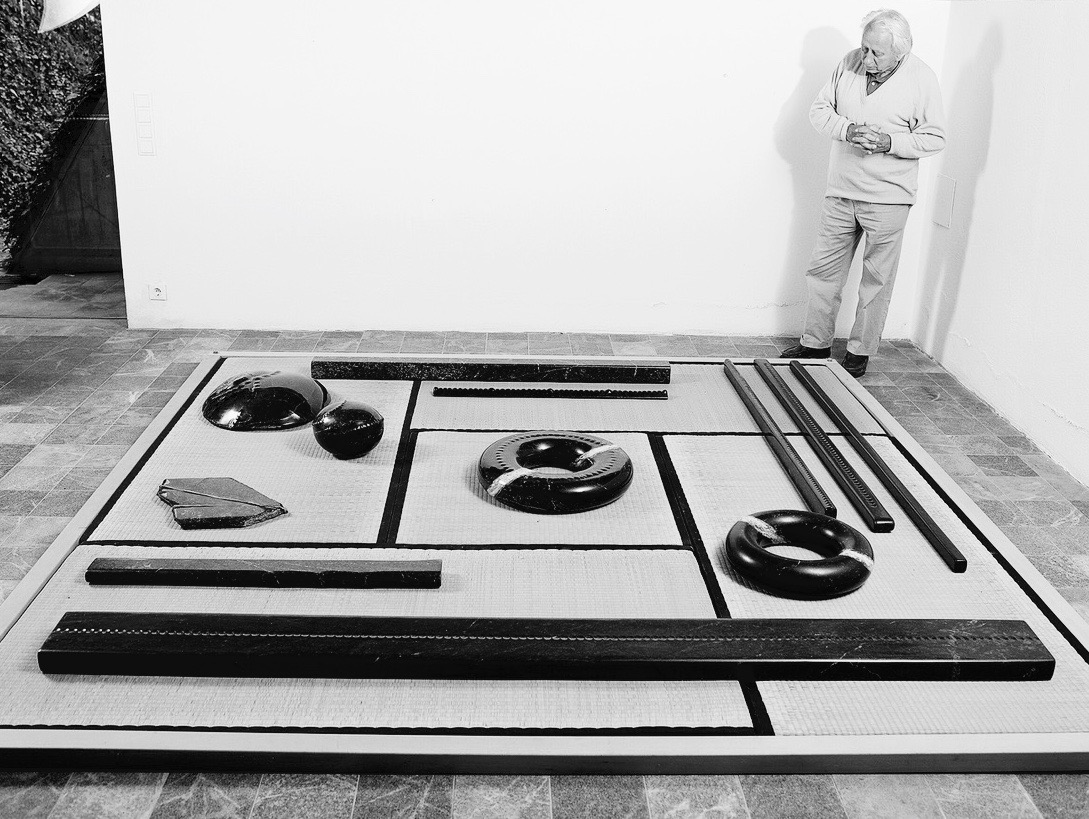
Karl Prantl - Meditation
Zurich
More topical than ever in the hustle and bustle of everyday life, the stones for meditation by the Austrian stone sculptor Karl Prantl bring peace to one's mind. A calmness evoked by the archaic and primordial nature of the material, by an extreme aesthetic reduction and the radical minimalization of the sculptural concept.
Despite his academic training as a painter, Karl Prantl is to be perceived as an autodidact - he nevertheless formed a clear unique selling point within modern Austrian sculpture, which, influenced by Fritz Wotruba, Joannis Avramidis, Rudolf Hoflehner and other artists, remained committed to - albeit abstracted - figurative sculpture.
For Karl Prantl,
stones were living beings
- once formed by nature
and eventually crumbling back
to dust.
An "aesthetic of stillness and inwardness" - evoked by balanced proportions and a refined play with positive and negative formations - is inherent in Prantl's sculptures. Even though the artist had worked in a wide variety of stone types, one often encounters dark granite and white marble. It is these stones that stand out for their hardness, resistance and sensitivity in reflecting light and their opaque surface, thus emphasizing Prantl's artistic intent. For Karl Prantl, stones were living beings - once formed by nature and eventually crumbling back to dust.
How earnestly he took the stone as his medium is shown by the careful elaboration of veins, inclusions, color and structure. This specific formal articulation resulted solely from working the stone by hand. Karl Prantl's stones, which adorned the Austrian pavilion at the Venice Biennale in 1986, are meant to be perceived not only mentally but also physically. Only by touching the stones can certain subtle modulations be perceived, can the coldness or warmth of the stone be experienced and grasped. Spiritual quality was for the sculptor the only concrete thing in his art.
However, the stones for meditation are not only a means and an end to a transitory process, but also a means to understand the originality and the relationship of man, art and nature.
Following an arrangement that Prantl had installed in his living and exhibition rooms in Pöttsching, Galerie Dierking shows an exquisite selection of smaller stones for meditation. The exhibition is intended as an invitation to pause for a moment and perceive the peace emanating from the stones, both visually and tactilely.
Karl Prantl - Meditation
Zurich
For Karl Prantl,
stones were living beings
- once formed by nature
and eventually crumbling back
to dust.
More topical than ever in the hustle and bustle of everyday life, the stones for meditation by the Austrian stone sculptor Karl Prantl bring peace to one's mind. A calmness evoked by the archaic and primordial nature of the material, by an extreme aesthetic reduction and the radical minimalization of the sculptural concept.
Despite his academic training as a painter, Karl Prantl is to be perceived as an autodidact - he nevertheless formed a clear unique selling point within modern Austrian sculpture, which, influenced by Fritz Wotruba, Joannis Avramidis, Rudolf Hoflehner and other artists, remained committed to - albeit abstracted - figurative sculpture.
An "aesthetic of stillness and inwardness" - evoked by balanced proportions and a refined play with positive and negative formations - is inherent in Prantl's sculptures. Even though the artist had worked in a wide variety of stone types, one often encounters dark granite and white marble. It is these stones that stand out for their hardness, resistance and sensitivity in reflecting light and their opaque surface, thus emphasizing Prantl's artistic intent. For Karl Prantl, stones were living beings - once formed by nature and eventually crumbling back to dust.
How earnestly he took the stone as his medium is shown by the careful elaboration of veins, inclusions, color and structure. This specific formal articulation resulted solely from working the stone by hand. Karl Prantl's stones, which adorned the Austrian pavilion at the Venice Biennale in 1986, are meant to be perceived not only mentally but also physically. Only by touching the stones can certain subtle modulations be perceived, can the coldness or warmth of the stone be experienced and grasped. Spiritual quality was for the sculptor the only concrete thing in his art.
However, the stones for meditation are not only a means and an end to a transitory process, but also a means to understand the originality and the relationship of man, art and nature.
Following an arrangement that Prantl had installed in his living and exhibition rooms in Pöttsching, Galerie Dierking shows an exquisite selection of smaller stones for meditation. The exhibition is intended as an invitation to pause for a moment and perceive the peace emanating from the stones, both visually and tactilely.
IMPRINT
© DIERKING 2025



